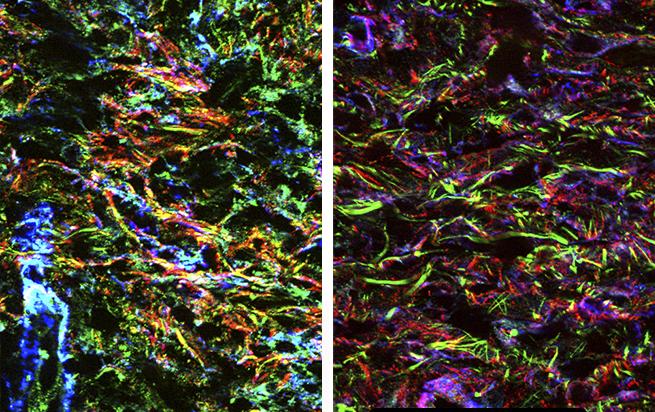Over-organizing repair cells set the stage for fibrosis

Compared with a control skin wound (left), the ECM within a wound containing increased numbers of myofibroblasts (right) is more consistently organized into linear fibers, which increases the activation and release of a growth factor that promotes fibrosis. Credit: Klingberg et al., 2014
Myofibroblasts are highly contractile cells that repair damaged tissues by replacing and reorganizing the extracellular matrix (ECM), the meshwork that fills the space around cells, in order to draw a wound closed.
When myofibroblasts are not properly regulated, however, they continue to act on healed tissues and produce excessive amounts of ECM. Excessive ECM production is involved in conditions such as fibrosis, the development of damaging scar tissue in organs.
Transforming growth factor β1 (TGF-β1) is a key signaling molecule within the ECM that promotes tissue fibrosis. Boris Hinz and colleagues previously found that myofibroblasts pull on inactive TGF-β1 complexes to release the active form of the signaling molecule from the ECM.
The University of Toronto researchers then wanted to find out whether the structural changes that myofibroblasts make in the ECM during wound healing might also make it easier for the ECM to release activated growth factor later in the process.
The researchers found that wounds containing increased numbers of myofibroblasts exhibited much higher levels of ECM organization, with components arranged into long, thin fibers. Hinz and colleagues then devised a series of experiments to test how this highly organized ECM configuration affects TGF-β1 activation.
They found that higher levels of organization and tension in the ECM always resulted in high amounts of activated TGF-β1 being released by the contractile force of myofibroblasts.
Their results indicate that, over time, as myofibroblasts remodel and stiffen the ECM during wound healing, the matrix becomes a loaded “mechanical spring” that puts strain on TGF-β1 complexes, causing them to be easily pulled apart and activated by contracting myofibroblasts.
Because TGF-β1 induces further myofibroblast activity and, ultimately, tissue fibrosis, limiting ECM reorganization during wound healing might therefore be an effective therapeutic approach to prevent fibrosis.
###
Klingberg, F., et al. 2014. J. Cell Biol. doi:10.1083/jcb.201402006
About The Journal of Cell Biology
The Journal of Cell Biology (JCB) is published by The Rockefeller University Press. All editorial decisions on manuscripts submitted are made by active scientists in conjunction with our in-house scientific editors. JCB content is posted to PubMed Central, where it is available to the public for free six months after publication. Authors retain copyright of their published works, and third parties may reuse the content for non-commercial purposes under a creative commons license. For more information, please visit http://www.jcb.org.
Research reported in the press release was supported by the Canadian Institutes of Health Research, the Collaborative Health Research Program, the Canada Foundation for Innovation and Ontario Research Fund, the Heart and Stroke Foundation Ontario, and the European Union's Seventh Framework Program.
Media Contact
All latest news from the category: Life Sciences and Chemistry
Articles and reports from the Life Sciences and chemistry area deal with applied and basic research into modern biology, chemistry and human medicine.
Valuable information can be found on a range of life sciences fields including bacteriology, biochemistry, bionics, bioinformatics, biophysics, biotechnology, genetics, geobotany, human biology, marine biology, microbiology, molecular biology, cellular biology, zoology, bioinorganic chemistry, microchemistry and environmental chemistry.
Newest articles

Sea slugs inspire highly stretchable biomedical sensor
USC Viterbi School of Engineering researcher Hangbo Zhao presents findings on highly stretchable and customizable microneedles for application in fields including neuroscience, tissue engineering, and wearable bioelectronics. The revolution in…

Twisting and binding matter waves with photons in a cavity
Precisely measuring the energy states of individual atoms has been a historical challenge for physicists due to atomic recoil. When an atom interacts with a photon, the atom “recoils” in…

Nanotubes, nanoparticles, and antibodies detect tiny amounts of fentanyl
New sensor is six orders of magnitude more sensitive than the next best thing. A research team at Pitt led by Alexander Star, a chemistry professor in the Kenneth P. Dietrich…





















